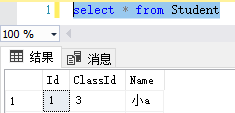此文更偏向于实施人员,开发人员的推荐看我写的另一篇随笔
1、通用表循环,常用于对一些分表的操作,比如这里有很多张表,表名类似delivery_0、delivery_1...的,就可以用这个来循环所有表来进行操作。原理是利用游标

declare @MyTableName varchar(255); declare My_Cursor cursor for select TABLE_NAME from INFORMATION_SCHEMA.TABLES where TABLE_NAME like 'delivery\_%' escape ''; open My_Cursor; fetch next from My_Cursor into @MyTableName; while (@@FETCH_STATUS = 0) begin exec('select * from ' + @MyTableName) fetch next from My_Cursor into @MyTableName; end close My_Cursor; deallocate My_Cursor
ps 还可以在循环中insert 数据到临时表,然后就可以聚集所有表的数据
2、通用表数据循环,常用于遍历表内数据。这个的应用场景比较多,譬如行转列、根据A表数据,插入B表及其子表数据(可以使用这个拿到B表当前插入最新记录的主键值,然后在插入子表数据时可以使用 set @XXId = ident_current('tableName');)

Declare @row int = 1, --行记录数 @count int,--总记录数 @XXid bigint; --XXId IF EXISTS(select 1 from tempdb..sysobjects where id=object_id('tempdb..#Temp')) BEGIN DROP TABLE #Temp END SELECT ROW_NUMBER() OVER (ORDER BY t.Id ASC) rowid, tableName.* into #Temp from tableName set @count = (select COUNT(1) from #Temp) while @row <= @count BEGIN select @XXid = XXid from #Temp where rowid=@row; set @row = @row +1; END
注1:If为判断语句,begin & end 相当于起止括号
注2:while为循环语句
注3:ident_current('tableName');为获取这个表的主键列的值
3、exec sp_executesql,当查询语句需要拼接(也就是字符串),或者需要从查询中给某个变量赋值时,使用这个
假设我们有一个Student表(有Id,ClassId,Name 三列)

declare @classId int = 0; declare @name nvarchar(10); declare @sql nvarchar(max); set @sql = N'select @classId = ClassId, @name = Name from Student where Id = 1'; exec sp_executesql @sql, N'@classId int, @name nvarchar(10) output', @classId, @name output; select @classId, @name;
执行结果如下,可以看到,即便在查询中给@classId赋值但没有写output,外面的@classId也不会改变其值,写了output的@name就成功赋值了。@sql里面的变量实际上是和外部不同步的,类似函数调用时的值传递,加了output就类似C#的ref修饰符(其他语言也有类似的语法吧),所以字符串里面的@classId可以写成@c或者别的,但为了提高可读性,写成了跟外部变量一样的名字
熟练以上3种写法后,再查一查官方文档,基本上就可以把sql当编程了,想怎么输出都可以,下面再讲一些不那么常用的写法
4、定义函数,这里以一个比较实用的分割字符串函数为例(2016版本后用String_Split,但2016版本前没有,还得自定义这个函数)

IF OBJECT_ID('STRING_SPLIT') IS NOT NULL DROP FUNCTION STRING_SPLIT go create FUNCTION [dbo].[STRING_SPLIT](@String varchar(8000), @Delimiter char(1)) returns @temptable TABLE (items varchar(8000)) as begin declare @idx int declare @slice varchar(8000) select @idx = 1 if len(@String)<1 or @String is null return while @idx!= 0 begin set @idx =charindex(@Delimiter,@String) if @idx!=0 set @slice =left(@String,@idx - 1) else set @slice = @String if(len(@slice)>0) insert into @temptable(items)values(@slice) set @String =right(@String,len(@String)- @idx) if len(@String)= 0 break end return end go
5、定义存储过程,主要是为了所谓的“原子性”,要么代码都执行,要么代码都不执行
{{先挖坑,以后再填}}
6、获取某表数据字典,可以搭配上面的【通用表循环】使用,所谓的数据字典就是打印出这张表的所有字段的简要信息

select col.name as '字段名', t.name as '类型', case when col.max_length = -1 then 'Max' else Cast(col.max_length as varchar) end as '长度', ISNULL(dv.[Default Value],'') as '默认值', case when col.is_nullable = 1 then '√' else '' end as '允许为空' from sys.columns col join sys.types t on col.system_type_id = t.system_type_id join (select SC.NAME AS "Column Name", SM.TEXT AS "Default Value", SO.name as 'Table Name', SC.colid as 'Col Id' from dbo.sysobjects SO JOIN dbo.syscolumns SC ON SO.id = SC.id LEFT JOIN dbo.syscomments SM ON SC.cdefault = SM.id) dv on col.name=dv.[Column Name] and col.object_id = OBJECT_ID(dv.[Table Name]) where t.name <> 'sysname' and col.object_id = OBJECT_ID(N'tableName') order by dv.[Col Id]
7、生成指定长度的随机字符串函数(本想随机插入一些用户名,但残念的是没有汉字)

if object_id('func_random','fn') is not null drop function func_random; go create function dbo.func_random(@length int) returns nvarchar(200) as begin declare @result nvarchar(200); declare @i int, @random int; set @result = ''; set @i = 0 ; while @i < @length begin select @random = ceiling(random*150) from v_random ; --调整此值产生的范围为0~150,可能概率不同了,随机程度不一样 if (@random between 48 and 57 ) OR (@random between 65 and 90) OR (@random between 97 and 122) --0~9 A~Z a~z begin SET @result = @result + nchar(@random) set @i= @i + 1 end end; return (@result); end go /*测试随机字符串函数*/ select dbo.func_random(10);
